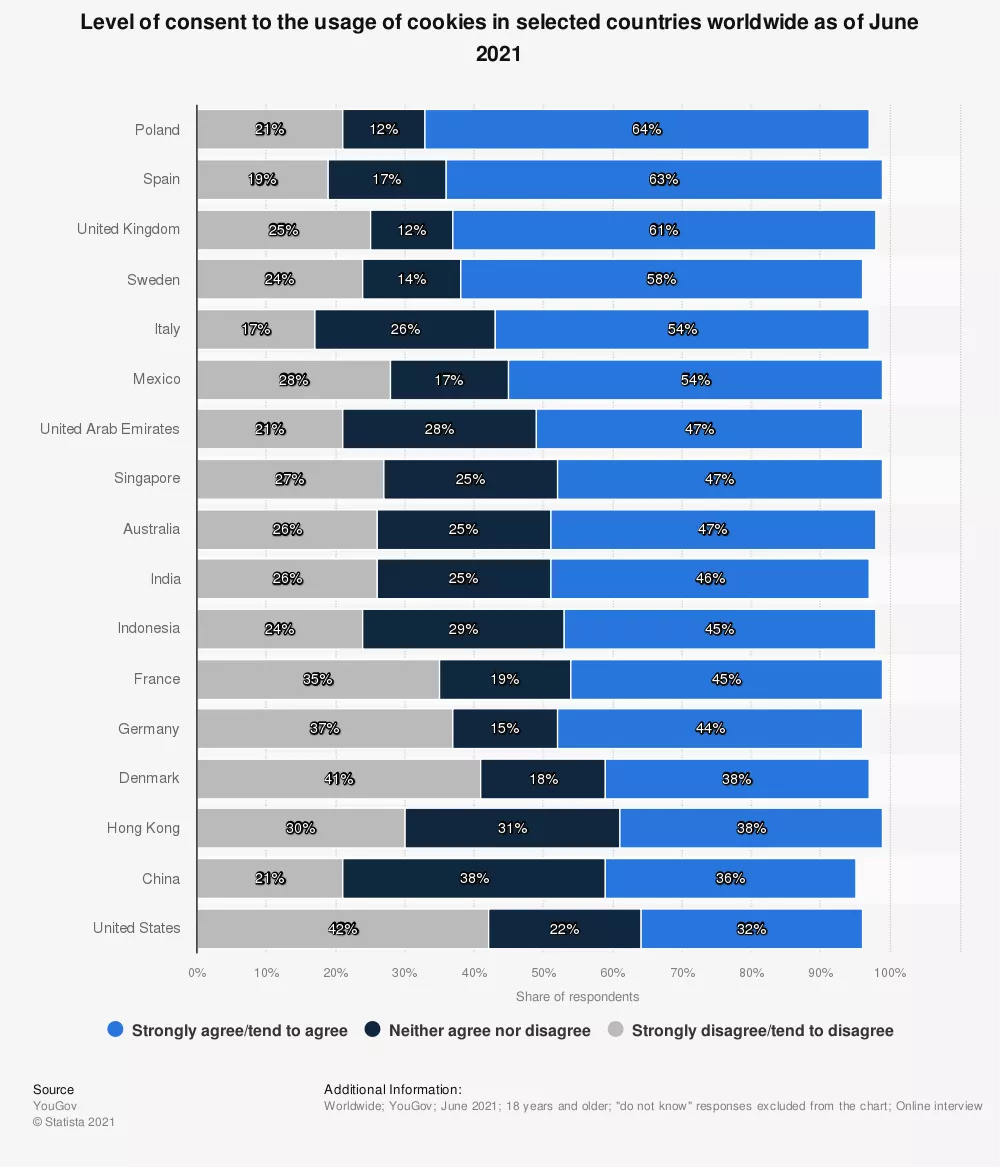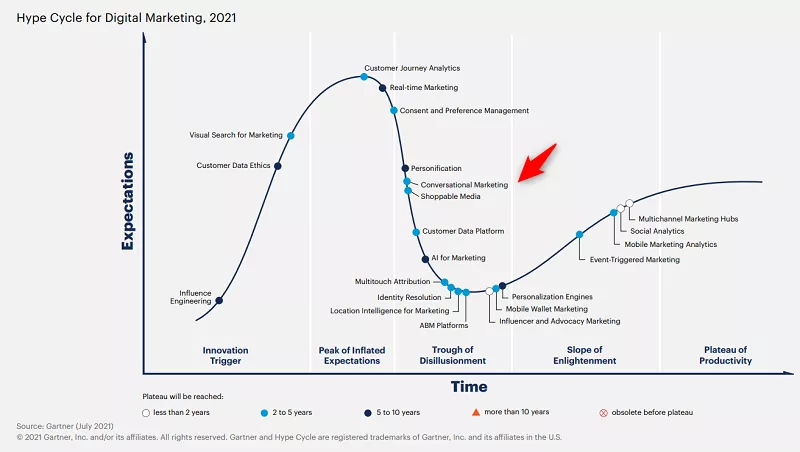Good marketing requires high-quality data. For a long time, tracking cookies delivered that data. However, more tech companies are restricting their usage, and a growing number of users is rejecting them. What now? Now, brands have to start talking directly to their customers. We explain why conversational marketing is the best approach.
Whenever marketers were looking for customer data, they turned to tracking cookies. However, slowly but surely, the cookies are crumbling. Internet browsers like Firefox and Safari already block the tracking technology. And even Google has jumped the anti-tracking bandwagon and will block third-party cookies in Chrome by 2023. In addition, more and more users are rejecting tracking cookies on websites.
For marketing departments, this means that important data is missing, whether it is for contacting customers, improving a product, or making the online experience more enjoyable for users. So now what? Where are you supposed to get the information from? Clearly, companies need to get to know their customers differently—through direct conversations. That's why brands should start using conversational marketing. In this article, we'll answer the following questions.
What are tracking cookies, and how are they used in marketing?
With growing concerns around data privacy, most people have heard of cookies before. Basically, cookies are a technology that allows website operators to see what visitors are doing on the site.
Which subpage has someone looked at? What items are in someone's shopping cart? The smart cookies store all of this information to make it easier to navigate websites. Imagine that you want to return to your shopping cart later, but the products you put in there are gone, and you have to restart the entire process. So, in many ways, cookies provide an improved user experience.
👉 Why you should use messaging apps for customer service
Cookies vs. tracking cookies
There is a technical distinction between "regular" cookies, which simply display user behavior, and tracking cookies. These are a specialized version, in which user information can be shared between several websites and services.
In marketing, cookies are very important to understand customers better, provide them with a more personalized experience, and also to avoid spam.
Tracking enables better user experience
Cookies can tell a company a lot of things. They can tell you which products on a website are well-received by customers, and which are not. This information can be used to improve the website, but also to make sure users are only shown products they are really interested in.
If, for example, you're interested in outdoor sports, you'll be happy to see offers for hiking gear, but most likely you don't want to see ads for kitchen furniture. In the end, cookies give companies relevant information to design a more personalized (and more enjoyable) user experience.
People have always collected customer data
Now, it's not as if marketing didn't collect data before the age of the internet. A successful customer approach simply depends on showing the right product to the right target group at the right time. It's just that before widespread internet use, it was much more difficult to collect high-quality customer data.
Information had to be obtained by (snail) mail, from phone surveys or, in some cases, simply through rough estimates and market surveys. Tracking cookies offered a decisive advantage. They were more precise, more individualized, and easier to access. But there are also some problems with the technology that have caused increasing distrust.
Why is the tracking cookie crumbling?
Due to some cases of data abuse and the increasing distrust against tracking technologies, cookies have moved more into the focus of consumers and politicians.
Tracking feels like Big Brother is watching you
Before the introduction of data protection laws, consumers were not informed transparently about what data cookies collected about them, what this data was used for, and to whom it was forwarded.
This created a kind of Big Brother feeling. For example, people would search online for new sneakers in the morning, and find an ad for the latest Nike shoes on social media in the evening. If users are not aware that the search engine is forwarding their data to social media platforms, they can quickly feel like they are being watched.
This made consumers suspicious not only of cookies, but also of the companies themselves. According to one survey, 75% of respondents said they didn't trust companies with their data. These concerns eventually led to political consequences, such as the European General Data Protection Regulation (GDPR) or the California Consumer Privacy Act (CCPA).
Privacy laws and growing awareness: users reject cookies
In recent years, you probably have noticed the constant pop-ups when you go to a new website, such as "We would like your consent...", or, "We respect your privacy...". These statements are asking users to give consent to websites to collect their data through tracking cookies.
In many countries, it has become a legal requirement to ask users to agree to tracking technologies. Given this choice, many of them explicitly reject tracking. According to a survey by YouGov, 25% of U.K. users reject cookies. In India it's 25%, and in the U.S., 42% of users don't want to be tracked by cookies.

Big Tech turns its back on tracking
More and more big tech companies have responded to consumers' desire for more privacy.
Safari launched its "Intelligent Tracking Protection" in 2017. It blocked third-party cookies that tracked user behavior across websites, and also restricted data storage. Since 2020, app developers for Apple's iOS have had to obtain explicit user permission for cookie tracking—which users can also refuse.
Firefox came out with its "Enhanced Tracking Prevention" in 2019. This blocks third-party cookies as a default setting. Previously, users could also choose this, but had to set it up manually. With the new policy, the browser made non-tracking the default setting. Since 2020, Mozilla has also blocked the sharing of cookie data between different websites.
And even Google has announced the end of third-party cookies by 2023. For the time being, the company has shelved plans to introduce individual user identifiers instead.
What comes after cookie tracking for businesses?
All of this poses a new problem for businesses, advertisers, and marketing departments. If you can't use cookies anymore to find out what your clients like, what can you do instead? The demise of cookies is only a problem at first glance.
When looked at closer, it mostly is an opportunity to collect higher quality customer data in a more ethical way. Companies can therefore move away from shady third-party tracking, and get valuable first-party data directly from their customers. This has many advantages.
- First, direct data collection is more transparent and puts consumers back in control of their data.
- This, in turn, creates more trust among customers, who are more willing to share their information with companies.
- To protect themselves from cookies, many people use ad blockers. As a result, many of your expensive, valuable and time-consuming campaigns do not reach your target group. If third-party tracking goes away, there is less need for the blockers and more campaigns will be noticed by your target audience.
- First-party data gives you more accurate information and individual insights.
- You can forge a direct relationship with your clients.
But how do companies get this kind of first-party data? It's actually quite simple: by talking directly to the customers through conversational marketing.
What is conversational marketing?
Conversational marketing simply means "having a conversation with your customers". Unlike the classic marketing approach, it's not about bombarding consumers with demands like "buy this" or "buy that". Rather, conversational marketing is about exchange and interaction.
While companies in conversational commerce try to sell something to the customer through dialog, conversational marketing is more about brand positioning, awareness and attention.
This means meeting your customers at eye level, taking their wishes, needs and criticism seriously—and responding accordingly. In other words, you find out what your customers actually want, by simply talking to them. Market experts like Gartner have been saying for years that conversational marketing is the future of marketing.

The big question, of course, is: how do you start a conversation with your customers? The answer is actually obvious, through messaging apps. Messenger apps like WhatsApp, iMessage or even SMS are the simplest, most elegant and most effective form of conversational marketing. Why? Because users are already chatting on these platforms! And this is exactly where a company can get directly involved in the conversation.
In the next stage, for automated dialogs, chatbots can also be a useful integration.
Why should brands start using conversational marketing?
There are several reasons why brands should now focus more on conversational marketing. First, as mentioned earlier, the demise of tracking cookies means that an important source of information is no longer available. Meaningful conversations with customers can provide exactly this information. And: this data is much more valuable than cookie data can ever be because it comes directly from the customers.
At the same time, customers have a more positive response to conversational marketing because it is more inclusive. Either customers approach companies directly, and ask them questions about a product or service on a messenger app. Or, they accept a company's invitation to talk to them, which also shows that they are interested in an exchange. In both cases, the conversation develops organically and with the customers' explicit interest.
In addition, brands use conversational marketing to talk directly with customers, instead of talking to them. And as we all remember from our school days: it is much more pleasant to talk to each other than having to listen to a lecture. Numbers confirm this.
- ⏩According to a recent survey, more than half of the companies (50.7%) that use conversational marketing are able to answer customer inquiries more quickly, something that customers increasingly expect.
- 💰 38% of consumers are willing to spend more money if they have live chat support when making a purchase.
- 🤖 Chatbots can be a great support for service teams and shoppers. They can reduce time spent to handle customer queries by 80%.
The future is conversational
Instead of worrying about the demise of cookies, brands should focus on more effective, transparent, and customer-friendly marketing strategies. Like conversational marketing.
Not only will this help your business more, it'll also provide a better experience for your customers.





